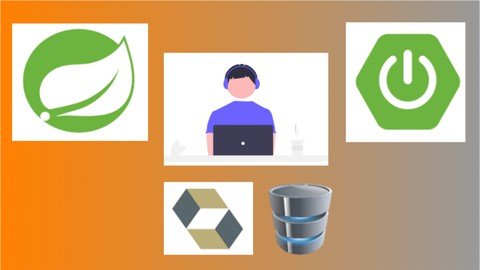
Published 2/2023
MP4 | Video: h264, 1280×720 | Audio: AAC, 44.1 KHz
Language: English | Size: 554.28 MB | Duration: 1h 0m
Learn all the concepts of Hibernate and Spring Data JPA to get ready for Interview
What you’ll learn
You will learn basics about ORM technology
You will learn the concepts of Hibernate Framework
You will learn about different objects in Hibernate
You will learn about of lifecycle of entity
You will about the different cache levels in Hibernate
You will learn about different types of queries in Spring Data JPA
You will learn about the basics of Database and SQL
Requirements
Basic knowledge of Spring Framework and SQL
Description
In this course, you will learn all the concepts of Hibernate and Spring Data JPA to get ready for an Interview.You will learn about the following:Hibernate ORM Framework – JPA ImplementationHibernate has a layered architecture that helps the user to operate without having to know the underlying APIs. Hibernate makes use of the database and configuration data to provide persistence services (and persistent objects) to the application.Hibernate Application Architecture with its important core classes.Configuration ObjectThe Configuration object is the first Hibernate object you create in any Hibernate application. It is usually created only once during application initialization.The Configuration object provides two keys components −Database Connection configurationClass Mapping SetupSessionFactory ObjectConfiguration object is used to create a SessionFactory object.The SessionFactory is a thread safe object and used by all the threads of an application.We would need one SessionFactory object per database using a separate configuration.Session ObjectA Session is used to get a physical connection with a database. The Session object is lightweight and designed to be instantiated each time an interaction is needed with the database. Persistent objects are saved and retrieved through a Session object.Transaction ObjectA Transaction represents a unit of work with the database and most of the RDBMS supports transaction functionality. Transactions in Hibernate are handled by an underlying transaction manager and transaction (from JDBC or JTA-Java Transaction API).Query ObjectQuery objects use SQL or Hibernate Query Language (HQL) string to retrieve data from the database and create objects. A Query instance is used to bind query parameters, limit the number of results returned by the query, and finally to execute the query.Criteria Object(Filtered Select query with many Where condition)Criteria objects are used to create and execute object oriented criteria queries to retrieve objects.HIBERNATE OBJECT STATESA new instance of a persistent class which is not associated with a Session, has no representation in the database and no identifier value is considered transient by Hibernate:// person is in a transient stateA persistent instance has a representation in the database, an identifier value and is associated with a Session. You can make a transient instance persistent by associating it with a Session:Now, if we close the Hibernate Session, the persistent instance will become a detached instance: it isn’t attached to a Session anymore (but can still be modified and reattached to a new Session later though).HIBERNATE CACHINGCaching is a mechanism to enhance the performance of a system. It is a buffer memory that lies between the application and the database. Cache memory stores recently used data items in order to reduce the number of database hits as much as possible.Caching is important to Hibernate as well. It utilizes a multilevel caching scheme as explained below −First-level CacheThe first-level cache is the Session cache and is a mandatory cache through which all requests must pass. The Session object keeps an object under its own power before committing it to the database.Second-level CacheSecond level cache is an optional cache and first-level cache will always be consulted before any attempt is made to locate an object in the second-level cache. The second level cache can be configured on a per-class and per-collection basis and mainly responsible for caching objects across sessions.Query-level CacheHibernate also implements a cache for query resultsets that integrates closely with the second-level cache.This is an optional feature and requires two additional physical cache regions that hold the cached query results and the timestamps when a table was last updated. This is only useful for queries that are run frequently with the same parameters.JPA offers 4 different ways to generate primary key values: @IdAUTO: Hibernate selects the generation strategy based on the used dialect,IDENTITY: Hibernate relies on an auto-incremented database column to generate the primary key,SEQUENCE: Hibernate requests the primary key value from a database sequence,TABLE: Hibernate uses a database table to simulate a sequence.SPRING DATA JPA – Abstraction layer built on top of HibernateSpring Data JPA, part of the larger Spring Data family, makes it easy to easily implement JPA based repositories. This module deals with enhanced support for JPA based data access layers. It makes it easier to build Spring-powered applications that use data access technologies.Implementing a data access layer of an application has been cumbersome for quite a while. Too much boilerplate code has to be written to execute simple queries as well as perform pagination, and auditing. Spring Data JPA aims to significantly improve the implementation of data access layers by reducing the effort to the amount that’s actually needed. As a developer you write your repository interfaces, including custom finder methods, and Spring will provide the implementation automatically.
Overview
Section 1: Basics Of Database and SQL
Lecture 1 What is Database and Database Server and Tables
Lecture 2 Real world Explanation of Tables Rows Relationship between Tables
Section 2: Basics of JPA , Hibernate and ORM
Lecture 3 Basics of JPA and ORM
Lecture 4 Hibernate Core Classes and Interfaces
Section 3: Hibernate Entity States, Cache Levels, Spring Data JPA and Queries
Lecture 5 Hibernate Entity States, Cache Levels, Spring Data JPA and Queries
Anyone who wants to refresh hibernate and spring data jpa concepts and be prepared for Interview
Homepage
www.udemy.com/course/get-interview-ready-with-springdata-jpa-hibernate-concepts/
vmzua.Get.Interview.Ready.With.Springdata.Jpa..Hibernate.Concepts.rar.html
Rapidgator
vmzua.Get.Interview.Ready.With.Springdata.Jpa..Hibernate.Concepts.rar.html
Uploadgig
vmzua.Get.Interview.Ready.With.Springdata.Jpa..Hibernate.Concepts.rar
NitroFlare
vmzua.Get.Interview.Ready.With.Springdata.Jpa..Hibernate.Concepts.rar










Leave a Reply
You must be logged in to post a comment.